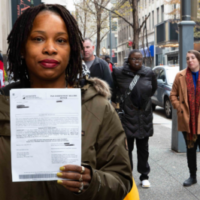Inflation-adjusted wages rise 20-28% for restaurant workers
New York, NY—Five years after New York State passed the first of several laws to gradually raise its minimum wage to $15 an hour, New York City’s restaurant industry continues to thrive, with strong growth in restaurant industry employment, wages, and the number of establishments around the city, according to a new report released today by the Center for New York City Affairs at The New School and the National Employment Law Project.
The report’s findings of a prospering restaurant industry are in sharp contrast to the “sky is falling” rhetoric of industry lobbyists who warned of massive job losses, $20 Big Macs, and shuttered restaurants. The report offers a first-of-its-kind assessment of restaurant employment and earnings over the entire period of the city’s historic minimum wage increases, during which the wage floor rose from $7.25 to $15.00 an hour.
The restaurant industry has the highest proportion of workers affected by the minimum wage of any industry. Researchers analyzed comprehensive employment, wage, and restaurant establishment data between 2013 and 2018 to assess the impact of the higher minimum wage on New York City’s restaurant industry. They found that during this period, New York City saw a strong economic expansion of the restaurant industry, outpacing national growth in employment, annual wages, and the number of both limited- and full-service restaurant establishments.
“We’re not saying that New York’s sharp minimum wage increase caused restaurant employment to soar—that’s likely due to the city’s faster private job growth,” said James Parrott, Director of Economic and Fiscal Policies at the Center for New York City Affairs at The New School and one of the report’s co-authors. “But our research is clear that the large wage floor rise did not diminish various indicators of restaurant performance, including job growth.”
Restaurants in Brooklyn, the Bronx, Queens, and Staten Island have seen particularly strong job and wage growth, despite lacking some of the advantages that Manhattan enjoys (such as high-spending tourists and generally higher-income patrons).
Because large cities generally have fared better economically in recent years than smaller cities and non-urban areas, the authors compared New York City restaurants to those in 12 large U.S. cities with populations over 500,000 where minimum wage levels were flat from 2013 to 2018. They found that even with the doubling of the minimum wage in New York City in this period, restaurant job growth in the city was greater than the average of the 12 large cities in the comparison group, and wage growth was much higher.
“Our report shows that workers in both full-service and limited-service restaurants have benefitted tremendously from New York’s rising minimum wage, with real wage increases from 2013 to 2018 averaging 15 to 23 percent for full-service and 26 to 30 percent for limited-service restaurant workers,” said Lina Moe, an economics graduate research assistant at The New School and one of the report’s co-authors. Moe continued, “Real wage gains of this magnitude for New York City’s low-wage workers haven’t been seen in the previous half-century.”
This analysis, which confirms the strength and sustained growth of the restaurant industry, provides further support for New York to eliminate its subminimum wage for tipped workers. Under current law, restaurant owners are permitted to pay tipped workers a lower cash wage than the overall state minimum wage, provided that tips received by such tipped workers bring the total earnings for each worker to the statutory minimum wage level. Elimination of the tipped wage is currently under consideration by the New York State Department of Labor and the State Legislature.
“New York can and should eliminate the tipped subminimum wage, as this would not only provide tipped workers with more economic security, but would also help narrow the gender wage gap,” said Yannet Lathrop, a researcher with the National Employment Law Project and a co-author of the report. “In New York, women constitute the majority of tipped workers and are subject to uncertain schedules and unpredictable incomes. As we discuss in the report, previous research finds that tipped workers have twice the poverty rate of non-tipped workers, and this level of poverty is worse in states like New York with a tipped subminimum wage. Eliminating the tipped subminimum makes absolute economic sense, and it’s also a matter of gender justice.”
The report also looked at other factors affecting New York City restaurants in recent years. While restaurant sales rose an average of 6.6 percent yearly starting in 2014 to reach nearly $22 billion in 2018, the industry has prospered in the face of several challenges. The rise in restaurant sales may have been tempered to some extent by the 20 percent rise in the value of the U.S. dollar from the end of 2013 to the end of 2018. This has eroded the purchasing power of foreign tourists visiting New York City, who account for an estimated 12 percent of all local restaurant spending. The rapid growth of venture capital-fueled third-party delivery services charging restaurants high commission fees, by many reports, has weakened restaurant profitability. The steady rise in real estate prices and rents in Manhattan in recent years has also challenged many restaurants whose long-term leases have expired. In some cases, such restaurants have been hit with steep rent hikes of 20-50 percent.
Among labor campaigns of the last few decades, the Fight for $15 has been one of the most effective in providing concrete benefits to working people, leading to the adoption of legislation raising the minimum wages in 25 states (seven of them to $15 per hour) and in more than 40 cities and counties. New York is among the states to have adopted a $15 minimum wage.
READ THE REPORT:
New York City’s $15 Minimum Wage and Restaurant Employment and Earnings
###
The National Employment Law Project is a non-partisan, not-for-profit organization that conducts research and advocates on issues affecting low-wage and unemployed workers. For more about NELP, visit www.nelp.org. Follow NELP on Twitter at @NelpNews.
The Center for New York City Affairs at The New School is an applied policy research institute that drives innovation in social policy. We conduct in-depth, original, and timely research that illuminates injustice, quantifies social change, and informs public policy. We identify practical solutions and fresh ideas to address pressing social and economic issues. We engage communities and policymakers and are committed to the debate of vital political and social issues.
Related to
The Latest News
All newsNew Survey of Jobless Workers Reveals How Critical Unemployment Insurance System Falls Short

News Release
Workers Rights Organizations Condemn the Dismantling of Workplace Civil Rights Enforcement Agency

News Release
March Jobs Report: Immigrant Workers Power a Steady Economy, Full Impact of Trump Policies Yet to Come

News Release
